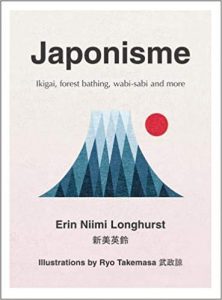
Author: Erin Niimi Longhurst
Rating: 7.5/10
In this gorgeous book, half British, half Japanese lifestyle blogger Erin Niimi Longhurst exploring the Japanese art of living a happier, healthier, more thoughtful life. In her own words, she “wants to inspire and provide guidance on ways to enrich and complement your lifestyle through a new lens.”
It’s broken down into three sections:
— Kokoro 心 – the heart and the mind, which includes the concepts of Ikigai (our purpose, what drives us to do what we do), Wabi-Sabi (the beauty of impermanence), and Kintsugi (finding beauty in imperfection);
— Karada 体 – the body, how we nourish it, how we engage with our surroundings, and how we stimulate our minds. It includes the concepts of Shinrin-yoku (forest bathing), Ikebana, Tabemono, Ocha, Onsen, Caligraphy, and the Japanese home.
— Shukanka 習慣化 — developing the habit.
The book is filled with gorgeous illustrations by Ryo Takemasa, pictures by the author, and beautifully designed Japanese proverbs, which makes it one of the most aesthetically pleasing books I’ve ever owned.
If you are curious about Japanese culture, or a Japanophile like yours truly, or looking for a gift for someone who is, Japonisme would be a great choice.
Highlights
“The thing that makes Japan’s culture and traditions so uniquely special is its long history of isolation. Japan has acquired such a strong, distinct and rich identity because it lacked external influence for so long. For over 220 years, Japan had an isolationist foreign policy, known as sakoku, meaning it was a ‘closed country’. Under the Tokugawa shogunate, relations and trade between Japan and the rest of the world were strictly limited. Few were allowed to leave the country, and few were allowed in from the early 1600s, in an attempt to counter the perceived threat of foreign, religious and colonial influence.”
“In Japanese, there are three words to describe the heart. The first is shinzou, the physical organ that beats within us all, and keeps us alive. (If a Japanese person tells you that their shinzou hurts, they’re K K not speaking metaphorically – get them to a doctor, pronto.) The second is ha-to, the shape of a love heart – the kind that you can’t escape until late February, once Valentine’s Day has passed. The third is kokoro. Heart, mind and soul are inextricably linked in the word kokoro. The nearest English equivalent might be conscience; it’s a mentality or a feeling and it describes the emotions and desires inside all of us.”
“Finding your ikigai isn’t something you come to consciously. It’s slowly revealed to you over time, in the moments that help you to get to know yourself. It’s never complete, and is constantly in flux.”
“When I was younger, my friends and I would share a koukan nikki, or a friendship swap diary, to document our best, worst and funniest moments of the school day. These diaries were readily available, usually with pre-printed categories to be filled in. Each friend would take a day, fill out a page, and pass it on the next day to the next friend. Then, over lunch, when we gathered together, we would share the most hilarious or cringe-inducing of the previous week. While it’s not really that sustainable for adult working life, I’m more than a little tempted to bring it back to document our next group holiday (I think it would be perfect at a music festival).” – a brilliant idea for holidays or trips.